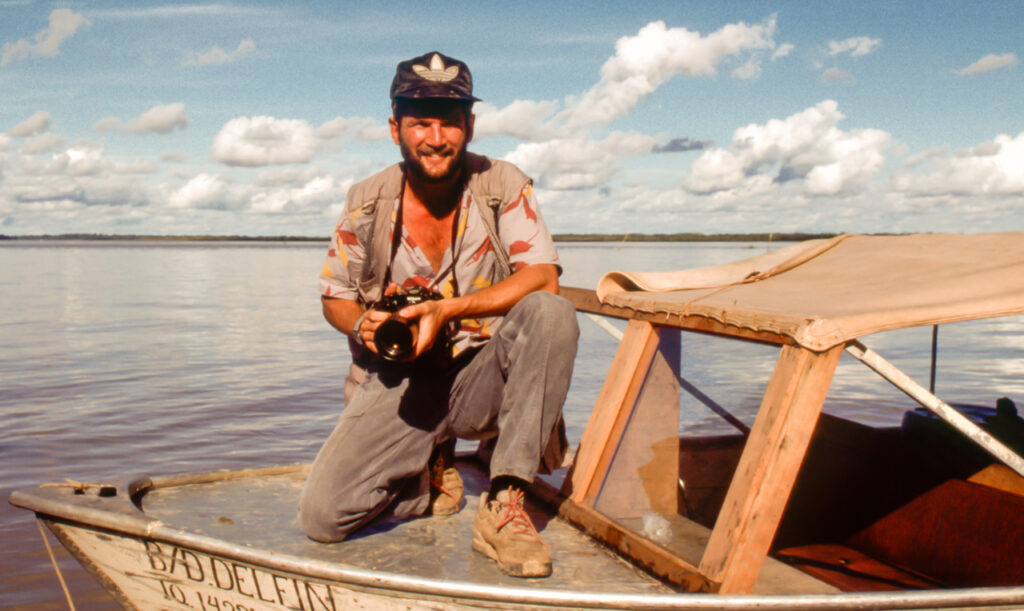Reserva Nacional Pacaya-Samiria, Peruvian Amazon – 1989
‘Destroying rainforest for economic gain is like burning a Renaissance painting to cook a meal.’ Edward O. Wilson
Those of you in my generation growing up in America probably had the same Sunday evening pastime as my family: we would watch the National Geographic specials. I loved that show and would dream of venturing off to far off, exotic lands in search of untouched natural wonders.
On one of those evenings I vowed that someday I would travel to the Amazon. But I didn’t want to go as a tourist and only see Amazonia from the periphery. I wanted some kind of local connection, someone who could embed me into the village life and take me beyond the tourist trail.
While in graduate school at the University of Wisconsin-Madison, I took a geography class in tropical agriculture. One of my classmates, Oliver Coomes, was doing a PhD in geography and said he’d be conducting his research in the Peruvian Amazon. I said I’d visit him and he no doubt assumed he’d never see me again but a few months later, I was in the Amazon port city of Iquitos and knocking on his door.
Oliver had hired a boat and a pilot and was getting ready to head upriver to his research location on a blackwater tributary called Rio Tahuayo. His PhD dissertation was looking at how the river dwellers made a living. I joined Oliver and we travelled upriver on the Amazon to the villages on the Rio Tahuayo. Oliver had already been welcomed into the river communities so we were able to sleep in the huts and join our hosts for meals which often consisted of piranha.
During the day, Oliver and I would venture out with the villagers and take part in whatever was on tap for the day like a community corn planting day, slashing the rain forest or putting the final touches on a dugout canoe.
Oliver decided to take a break from his research and we travelled further upriver to the Pacaya-Samira National Reserve. The Pacaya-Samiria is the second largest reserve in the Amazon and at the time was very rarely visited and had virtually no infrastructure.
It occupies 1.5% of Peru and protects a ridiculously rich pool of biodiversity including more than 500 species of birds and 100 of mammals (including the pink dolphin). Like all protected areas in developing countries it was struggling to protect its biological riches due to pressures from all aspects of ‘development’.
Two years after I visited, the reserve made news as Texan oil companies were offering the Peruvian government big money to give them drilling rights in the reserve. I believe the Peruvian government saw the long-term gains in the preservation of wildlands and did not sell out for the short-term economic gains. I’m not sure what pressures the reserve is under now but eco-tourism has arrived and now a travel lodge brings in tourists. With a biodiversity as rich as the Pacaya-Samiria has surely eco-tourism would generate more long-term wealth for the Peruvians than some drilling rights.
We sat in our little boat for hours as we ventured deeper and deeper into the reserve and soon I was getting delirious from the endless walls of green lining the river and the constant shrill and screams of insects, birds and frogs. As we rounded another bend in the river that solid green wall was broken by a flock of great egrets. I had to pinch myself to make sure I wasn’t dreaming about being in the inner depths of Amazonia and that I wasn’t watching a National Geographic rerun.
Eventually we arrived at the post of the lonely park guards who were very keen to have some visitors. In the tropics you are constantly hot and sticky but I didn’t go for my evening bath in the river. While we were on the Rio Tahuayo I’d bathe in the river and the piranhas would nibble harmlessly on my toes. But here in the Pacaya-Samiria the piranhas just seemed bigger and hungrier and the truth is I was simply afraid to plunge into those black Amazonian waters not knowing what lurked beneath. Instead of the piranhas eating me, the park guards fished a few out and we ate them for dinner. The fish wasn’t enough to satisfy the hunger of the park guards and they went out at night to dig up eggs of nesting river turtles. That seemed a bit hypocritical to me for park guards to do that but it was typical of guards in developing countries where they are so poorly equipped and provisioned that they have to scrounge for food.
Oliver went on to finish his dissertation and is now a professor of geography at Canada’s prestigious McGill University. I kept thinking of those National Geographic specials and returned to Iquitos and then continued south to the old Inca capital of Cusco, then Machu Picchu and Bolivia’s Lake Titicaca. All magical names which once rang out in our living room on Sunday evenings.


